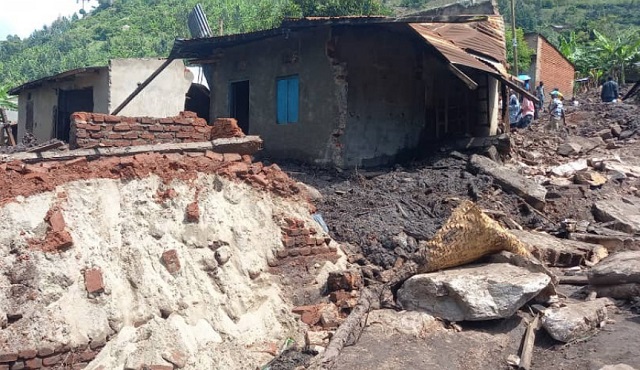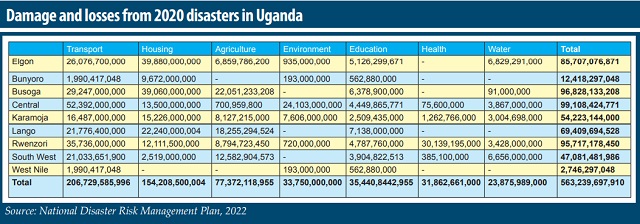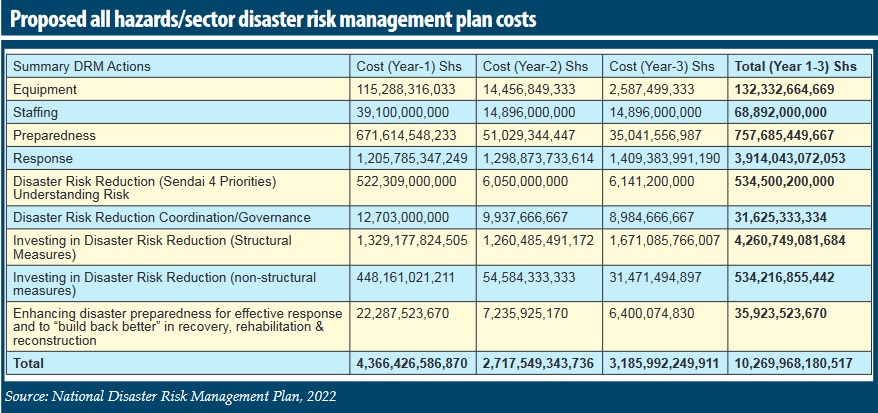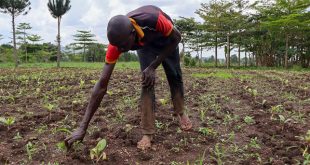
DISASTER MANAGEMENT: Govt asks donors for Shs 10 trillion
Kampala, Uganda | RONALD MUSOKE | The government is designing a new disaster risk management plan and accompanying standard operating procedures guide, according to Rukiah Nakadama, the third Deputy Prime Minister.
At a meeting held in Kampala on Sept.21, Nakadama told representatives of donor agencies; including the European Union, USAID and the World Bank that the government needs money to urgently invest in technology and modern equipment for disaster preparedness and response.
She said a cabinet meeting chaired by President Yoweri Museveni in July this year directed the Office of the Prime Minister to come up with a detailed costed plan to guide the government in resource mobilization and response.
The government wants donors to help it mobilise about Shs 10 trillion (US$2.77 billion) over the next three years to fight natural disasters that are beginning to dent Uganda’s economy.
Experts in disaster risk management say significant increases in disaster impacts are negatively affecting the ability of the government to sustain Uganda’s socio-economic and political gains. As a result, these disasters are retarding the projected pace of development.
Should the donors agree to fund the new plan, the government intends to, among other things, buy an assortment of earth moving equipment; bulldozers, excavators, wheel loaders, graders, and hi-tech equipment including; satellite phones, GPS devices, high frequency radios, night vision equipment, protective equipment/gear, temperature guns, fire extinguishers, and projectors among others to deal with the calamities better.
“Our people have faced landslides, floods, mudslides, hailstorms, and lightning, among other disasters (but) our capacity to respond and also build the required resilience and preparedness to the causes and effects of disasters has been hampered by other demands.”
“But the commitment of the government remains unwavering,” she said. Nakadama noted how the previous decade has seen Uganda experience catastrophic disasters that have cost Uganda hundreds of lives and livelihoods.
She mentioned the most recent disasters; the floods in Mbale City in eastern Uganda where 29 people died in July, the Kasese landslides in the Rwenzori region in western Uganda where 16 people perished in September and the famine in Karamoja in northeastern Uganda, which has left hundreds of people dead.
She also mentioned earlier incidents of landslides in Bududa in the Mt.Elgon region, displacements in Bundibugyo, Kapchorwa, Bulambuli, Nakasongola, Ntoroko, Buliisa, Rubanda, Amolatar, Teso sub-region, Kayunga and the entire L. Kyoga Basin over the last couple of years.
Nakadama put the cost of damage to critical infrastructure including roads, bridges, schools, health centres and power stations at Shs563 billion in 2020 alone. In previous years, the government estimates the cost of the damage to have been much higher, she said.

Disastrous economic losses
According to local disaster risk reduction experts, disaster loss and damage is on the rise in Uganda with grave consequences for the survival, dignity and livelihood of Ugandans, particularly the poor. They add that the natural disasters are not only increasing in frequency but also in intensity.
According to the World Bank, over the last century (1900-2018), more than 200,000 people have died due to combined impacts of disasters. These disasters include at least 20 flood incidents, 40 epidemics, nine droughts and five landslides. More recently, the same report estimates that droughts have affected close to 2.4 million people between 2004 and 2013.
According to the 2020 national risk and vulnerability atlas for Uganda, the damage and loss attributed to drought was Shs 2.8 trillion. In 2016 alone, drought left about five million people food insecure and about Shs25 billion diverted from development programmes to relief.
Meanwhile, floods affect all regions in Uganda with over 80% of the districts prone and over 25% of the population exposed to impacts of floods. Each year, it is estimated that the impact of floods in Uganda amounts to about US$ 62 million and directly affects 50,000 people.
According to the 2020 State of Disaster Report which shows the most recent geographical spread of disaster risks by region and economic losses and damage, the natural calamities affected eight regions and 51 districts across the country.
The report mentions the main drivers of disaster risks as poverty and inequality. Others are poor living conditions, climate change and non-disaster risk informed policies. More specifically, the report mentions lack of regulations and incentives for private disaster risk reduction investment, unplanned rural-urbanisation processes, environmental degradation, lack of regulations and limited enforcement, unsustainable uses of natural resources, declining ecosystems and pandemics and epidemics.
The response
According to the national policy for disaster preparedness and management, the government has a financing mechanism of its disaster response.
In 2015, for example, the Public Finance Management Act (PFM Act, 2015 as amended) provided for funding the management of disaster preparedness, mitigation and prevention.
Section 26 of the PFM Act, 2015, established a Contingencies Fund which in every financial year is meant to be replenished with an amount equivalent to 0.5% of the previous year’s total appropriated national budget. But the Fund has never been operationalized.
“We need enhanced funding to finance the (disaster management) plan. Secondly, we need to establish regional centres for effective coordination of disaster response and to also support the District Disaster Management Committees,” Nakadama told the donors. She added: “We also need resources for mitigation, preparedness and prevention to induce disaster losses.”
“It’s my hope that you will keep your doors, and most importantly, your purses open when we reach out to you,” she said.
In August, this year, Hillary Onek, the Minister for Relief, Disaster Preparedness and Refugees told the Committee on Presidential Affairs that the government has developed a “robust disaster risk management plan that will mitigate impending disasters across the country.” Onek said the Office of the Prime Minister is set to establish five regional centres to manage disasters.
This, according to the minister, will cost the government about US$ 234 million. “We intend to confront the impending disasters by positioning ourselves regionally so that response does not only come from Kampala,” he said. According to Onek, the government has already committed US$ 50 million to establish these systems of response to disasters in the country.

Key gaps
Yet, despite a growing understanding and acceptance of the importance of disaster risk reduction and increased disaster response capacities, disasters and in particular the management and reduction of risk, continue to pose a national challenge, experts say.
For instance, there is often slow action in disaster preparedness and response. Experts say the disaster risk management coordination structures have been disjointed for a long time. And this is not the only challenge. Although there has been a bit of funding for disasters, this has often been limited to domestically available resources which mostly have been channelled response.
There are also limited capacities and capabilities at district and sub-district levels for disaster risk management coordination, planning and disaster responses.
Meanwhile, risk, hazard and vulnerabilities analyses and understanding has been limited to macro-level with narrow understanding at the micro level (parish, community and district levels).
Given the effects that disasters are having on the economy, groups such as the Civil Society Budget Advocacy Group (CSBAG), a consortium of civil society organisations and individuals in Uganda that often engages the government in influencing budget processes, say the government is still spending the bulk of resources on managing and responding to disasters as opposed to managing and reducing disaster risk.
At the donor conference, Makiko Watanabe, a senior specialist in global practice for social, urban, rural resilience, said Uganda is already incurring exorbitant losses due to natural calamities.
She said up to US$ 1.2 billion is lost in displacement shocks while drought is causing economic losses of close to US$290 million on average every year. “Responses towards natural calamities can be very expensive compared to preparedness,” she said.
Annet Kandole Balewa, an independent consultant on environmental governance and disaster risk reduction also told The Independent recently that what is clear from recent incidents of natural disasters happening around Uganda is that the governments is still failing to plan effectively for natural disasters.
“We still look more at the response but not in terms of preparedness. The government cannot keep delegating its duty to non-state actors well knowing that some of these organizations’ funding has been affected by COVID-19.
Instead, Kandole said, the government should start by mapping the country’s risk zones and enforcing some of Uganda’s existing environmental laws and restoration programmes along hillsides, river banks, wetlands and lake shores.
“We need to stop getting surprised by the extreme weather episodes,” she said.
****
 The Independent Uganda: You get the Truth we Pay the Price
The Independent Uganda: You get the Truth we Pay the Price




Kandole said it all…. let’s begin by mapping of the risk zones…. the areas prone to crisis and disaster in this country are known…. but our people (and leaders) are interesting creatures…they think by an of providence these risks will suddenly be wiped out…they fold their hands in wait but sadly, they don’t….let government engage in acquiring new technologies in cases of early warning….let government streamline the departments and agencies involved in disaster response and management….let government carry out international lobby in terms of logistics…. disaster management begins with planning….and unfortunately, every time we’re with a disaster, we respond with quick fixes… firefighting and stop-gap-measures….. there needs to be a comprehensive approach to disaster management..
Dear editor
It’s only last week the president was berating the Wazungu- EU donors for frustrating his oil pipeline project – now the government is coming with the begging bucket to donors to fund its disaster plans. What a funny world!